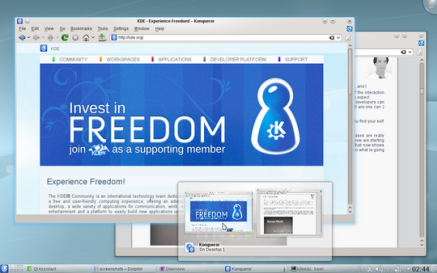Tech
KDE 4.5 released - 1,723 new features, 16,022 bug fixes
News for all your Linux folks - KDE 4.5 has been released, and it contains a 1,723 new features, along with 16,022 bug fixes.

News for all your Linux folks - KDE 4.5 has been released, and it contains a 1,723 new features, along with 16,022 bug fixes.
Plasma Workspaces has seen quite a revamp. Here are some of the highlights:
- The notification area in the panel has been cleaned up visually. Monochromatic icons give visual clarity, and more consistent user interactions improve usability. Download tracking and indicators for other long-running operations, which are centralized in the notification area, are now handled by a visual progress indication in the widget itself. Likewise, the display, categorization and queueing of application notifications has been reworked. Notifications from shared Plasma widgets on remote systems may now be displayed as well as local events.
- KWin, the window manager component of the Plasma Workspace, can now lay-out windows on the screen without overlapping using tiling algorithms. Following a defined set of rules, KWin takes care of placing windows for the user. It is now also possible to easily move windows around by dragging an empty area inside the window. This new feature improves window handling ergonomics by allowing empty space to be used as drag handles. This feature will only work with Qt-based applications, as it requires some integration with the underlying toolkit to work properly. Adding and removing virtual desktops can now be done directly from the pager and desktop grid effect. Alongside these changes, many systems will enjoy improved window effects performance.
- Plasma Workspace Activities: the Zooming User Interface (ZUI) of the previous Plasma Desktop releases has been replaced by an "Activity Manager", similar to the Add Widgets dialog introduced with the 4.4 release. The new Activity Manager provides adding, removing, saving and restoring of Activities, and allows to switch between them. The visual concept of an Activity has been extended as well. Activities are now easier to manage and can aid users in their daily computing needs, providing them with a clearer separation between different tasks. The new Activity Manager is the first visible piece of context-awareness brought into Plasma through the use of Semantic Desktop features provided by Nepomuk.
- Plasma Netbook, the KDE Workspace for small notebooks and netbooks, has received substantial improvements with this release. Many of the changes are not immediately visible, but do provide a more pleasant netbook experience with higher performance and better touchscreen capabilities.
KDE Development Platform also gets some cool new features:
- After years of work, the integration for WebKit has been come part of our libraries. WebKit now provides a integration with password storage and other features in Konqueror, the KDE web browser. Other applications can make use of WebKit to display content with the same level of integration as KHTML.
- KHTML continues to develop, gaining support for XPath queries.
- Web content performance has been increased using a new scheduling policy, allowing for more parallel downloads of content from distinct servers, in turn enabling pages to be rendered faster as more of their components are loaded together. Both the page-rendering speed of the KHTML and the WebKit engines benefit from these changes.
- Plasma Workspaces can now be configured using JavaScript templates which can be distributed as small, separate packages. This makes it possible for system administrators and integrators to easily set up custom Plasma configurations for users, or to change the default setup of a standard Plasma Desktop.
- KSharedDataCache is a caching mechanism for applications. This new memory-mapped cache is already used for icons and demonstrates noticeable speed-ups there.
KDE Applications have also received a lot of love:
- The KDE Games team has worked on new features and introduced a new game: Kajongg, the original four-player Mahjongg. This game is written entirely in Python, making it the first major Python KDE Application as part of the KDE Games family. The game Konquest, in which the player is tasked to conquer the galaxy, now lets users create and customize their own maps. Other improvements are easier configuration in the jigsaw puzzle game Palapeli, a new KGoldRunner level set (“Demolition”), and better SGF file integration for Kigo.
- The educational applications have also seen several improvements. The biggest were for the learning aid, Parley, which has gained a new practice interface and support for conjugations.
- Marble, our virtual globe application, received a route planning feature and the option to download map data before you go on a trip so you do not need access to the Internet to make use of Marble and its mapping features based on OpenStreetmap and OpenRouteService data. Read more about worldwide and offline map routing in Marble.
Packages should be available for Linux distros shortly.
